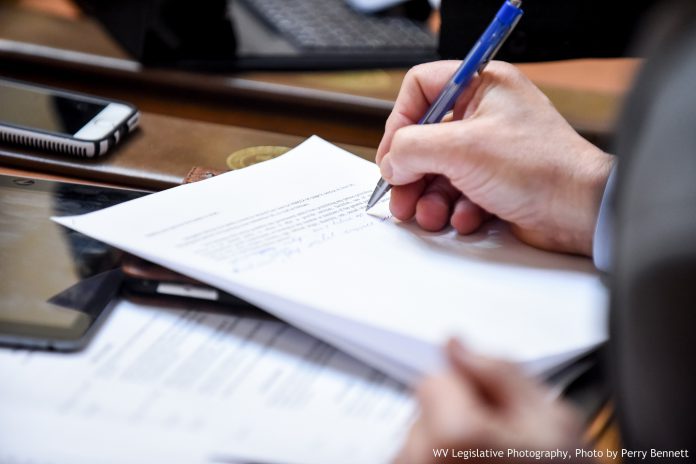
This past Monday, January 30th, 2006, marked the 20th day on the Legislative Calendar, the first of several deadline days for the Regular Session. It also was the submission date for Legislative Rule-Making Review bills.
Rule-making bills are an important yet often overlooked aspect of the work that goes on during a legislative session. So what exactly is a rule?
As defined in WV Code Chapter 29A-1-2, a rule is a regulation or standard affecting private rights, privileges or interests or the procedures available to the public. A rule is adopted by an agency to fill in the blanks in the law.
There are three types of rules that also are defined in the WV Code. First, a Legislative Rule is a rule, which, when authorized by Legislature, has the force of law, supplies a basis for the imposition of civil or criminal liability, or grants or denies a specific benefit. A Legislative rule is determinative on any issue affecting a citizen’s rights, privileges or interests.
Second, an Interpretive Rule is adopted by an agency to provide information or guidance to the public regarding an agency’s interpretations, policy or opinions upon the law enforced or administered by it.
Finally, a Procedural Rule is a rule that fixes rules of procedure, practice or evidence for dealings with or proceedings before an agency.
Interpretive and Procedural Rules follow the same procedure for promulgation, which is putting a law into action or force. An agency must file a notice with the State Register, located within the Secretary of State’s Office, no less than 30 days or more than 60 days before the end of the comment period. The rule gets considered for adoption, whereupon a notice of adoption or withdrawal is filed with the State Register. If a rule is adopted, the text of the rule with the notice for adoption is then filed.
The other type of rule, a Legislative Rule, follows a slightly different procedure. A notice of public comment is first filed with the State Register. A copy of the proposed rule is then filed with the Legislative Rule-Making Review Committee (LRMRC). The Committee is comprised of six members of both the House of Delegates and the Senate, chief counsel, four associate counsels and a staff person. At the end of the public comment period, one copy of the Agency Approved rule gets filed with the Secretary of State and 15 copies go to the LRMRC.
The filings with the LRMRC must show the amendments to a current rule by strike-throughs and underlines and also must contain a brief summary of the proposed rule. Also, a statement of the circumstances requiring the proposed rule and a fiscal note must be included.
The Committee decides whether an agency has exceeded the scope of its statutory authority and whether the proposed rule conforms to legislative intent. Finally, the Committee must decide whether or not the proposed rule conflicts with WV Code or any other rule.
The committee also analyzes the proposed rule to determine whether the rule is necessary and reasonable, could be made less complex and whether the rule was proposed for promulgation in compliance with the requirements of State Code.
Following those determinations, the LRMRC may recommend that the Legislature authorize the proposed rule, that they authorize it with modifications, that they authorize it with amendments or that the agency should withdraw the proposed rule.
After a determination is made, and a rule is to be authorized, one copy of the modified rule must be filed with the Secretary of State and 10 copies must be filed with the LRMRC. The Committee’s staff then drafts a bill of authorization for each proposed rule. The Committee then submits its final report to the Legislature and the bills of authorization are introduced in each chamber. As of January 31st, 105 rule-making bills have been introduced. For instance, Senate Bill 377/House Bill 4219 would authorize the Division of Natural Resources to promulgate a legislative rule relating to falconry. The proposed rule would allow a non-resident falconer who possesses a valid falconry permit from another state that meets falconry standards and is listed in the appropriate federal regulations, to pay an initial $100 fee and an annual renewal fee of $100.
Now, the bills are like any other bill introduced and must go through the same process all bills go through in becoming law. If a bill of authorization passes, then the affected agency may promulgate/proclaim the rule. However, if a bill is not approved, then the agency cannot declare the rule valid.
After an authorizing bill passes the Legislature, the agency must promulgate the rules within 60 days of the effective date of the bill. The rule becomes effective 30 days after it is filed or on the date provided for in the bill.
One other type of rule bears mentioning. An Emergency Rule is often used when the Legislature is out of session. Emergency Rules are necessary for the immediate preservation of the public peace, health, safety or welfare. Also, to comply with a time limitation, state or federal law, rule or regulation and to prevent substantial harm to the public interest, an Emergency Rule is used.
An agency must file an emergency rule, together with a statement of the facts and circumstances creating the emergency with the Secretary of State and the LRMRC. Emergency Rules become effective upon approval by the Secretary of State in most cases or, in the case of a proposed Secretary of State Emergency Rule, the Attorney General or upon the 42nd day after filing, whichever happens first.

